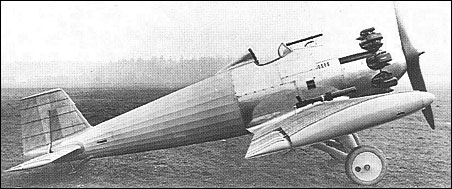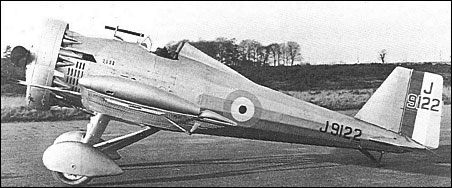|
| During the mid 'twenties, the Air Ministry accepted the philosophy that the primary concern of the RAF's fighter element should be interception of intruding enemy bombers. Accordingly, a specification was drawn up for a single-seat day interceptor capable of
overtaking an enemy aircraft flying at 241km/h at 6100m. This specification, F.20/27, resulted in contending monoplanes being ordered from de Havilland, Vickers and Westland. The Vickers design, the Type 151, was constructed on Wibault principles, but the rear portion of the fuselage was fabric covered. Power was provided by a nine-cylinder Bristol Mercury IIA radial engine rated at 480hp at 3960m, provision was made for an armament of twin 7.7mm Vickers guns, and the manufacturer assigned the appellation of Jockey to the fighter. Among novel features embodied by the Type 151 was a sideways-hinging engine mounting to ease accessibility for maintenance, all controls, wiring and piping, and even the Constantinesco gun synchronisation equipment hinging without disconnection.
Designed by Rex Pierson and J Bewsher, the Type 151 was flown in April 1930, but oscillation and inadequate torsional rigidity in the rear fuselage were encountered. Various palliatives were applied, such as wing root leading-edge slots to rectify the buffeting that was believed to create the problems, but these proved ineffectual, and in January 1932, when the Mercury IIA gave place to a 530hp Jupiter VIIF, structural redesign of the rear fuselage was undertaken. It was intended to re-engine the Type 151 once more, this time with a Mercury IVS2 supercharged power plant, but, in June 1932, before this change could be made, the fighter failed to recover from a flat spin while undergoing trials at Martlesham Heath. Progressive redesign of the Type 151 was subsequently undertaken as the Jockey II, which, in its definitive form, was submitted to meet Specification F.5/34 as the Venom.
 | A three-view drawing (1280 x 890) |
| WEIGHTS |
| Take-off weight | 1434 kg | 3161 lb |
| Empty weight | 1025 kg | 2260 lb |
| DIMENSIONS |
| Wingspan | 9.90 m | 33 ft 6 in |
| Length | 7.01 m | 23 ft 0 in |
| Height | 2.51 m | 8 ft 3 in |
| Wing area | 13.93 m2 | 149.94 sq ft |
| PERFORMANCE |
| Max. speed | 351 km/h | 218 mph |
| Mike White, e-mail, 07.08.2016 02:06 Does anyone know of the availability of a good 3 view (say 1 /48 scale or larger)? I will be building an r /c version of about 85 inches span, maybe even 100 inches, during the winter. I will also try British Aerospace in case they have some drawings but any help will be most appreciated. reply | | William Kern, e-mail, 15.07.2011 02:37 Actually, men, the P-26 "Peashooter" was built by the Boeing Company, not Curtiss. The Vickers 151 might have been a better plane if it had been fitted with streamlined flying wires similar to the P-26, and a dorsal fairing forward of the vertical tail to strengthen the aft fuselage. I'm working on a 1 /32nd scale model. reply | | paidui, 21.06.2011 05:50 wiring and piping, and even the Constantinesco gun synchronisation equipment hinging without disconnection. reply | | William Harvey, e-mail, 02.09.2010 23:22 An English Curtiss Peashooter but very pretty and definitely would have beeen superior if the engine could have been up graded. Trailing edge flapes made it ideal for great landings in short spaces. C of G was close to perfect as it was almost inside the cockpet zone. Wing flutter at high speed was a serious issue. reply | |
| | Rodney Salter, e-mail, 01.02.2010 18:15 Or the Boeing P-26! reply | | Johned, e-mail, 14.07.2009 11:22 Similar to the Curtiss Peashooter reply |
|
Do you have any comments?
|
| 
COMPANY
PROFILE
All the World's Rotorcraft
|








